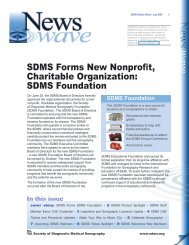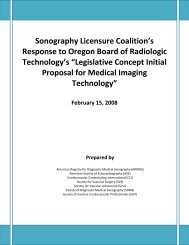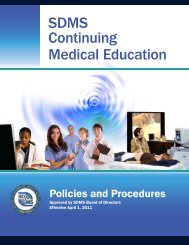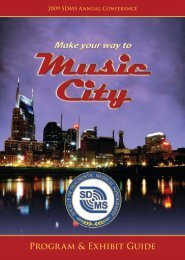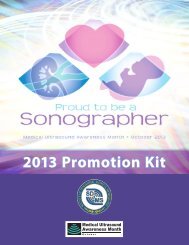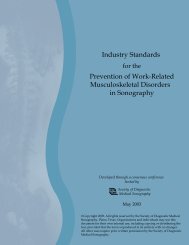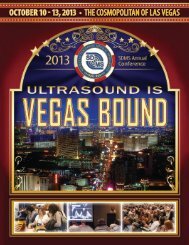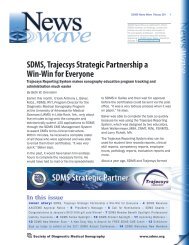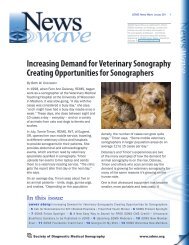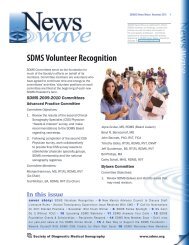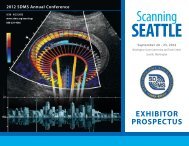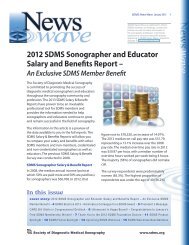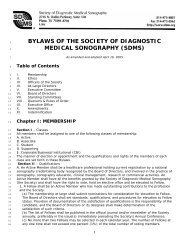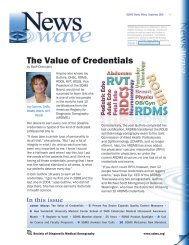Sonography's Future and Past - Society of Diagnostic Medical ...
Sonography's Future and Past - Society of Diagnostic Medical ...
Sonography's Future and Past - Society of Diagnostic Medical ...
Create successful ePaper yourself
Turn your PDF publications into a flip-book with our unique Google optimized e-Paper software.
In this issue<br />
SDMS News Wave December 2008 1<br />
SDMS News Wave is published to inform<br />
SDMS members <strong>of</strong> meetings, events <strong>and</strong><br />
policies as well as trends <strong>and</strong> issues in<br />
the sonography pr<strong>of</strong>ession. Comments,<br />
questions or concerns about the articles<br />
appearing in SDMS News Wave, should be<br />
directed to newswave@sdms.org.<br />
Sonography’s <strong>Future</strong> <strong>and</strong> <strong>Past</strong><br />
Don Baker sees new applications for sonography while Joan Baker looks back .<br />
By Beth W. Orenstein<br />
In the television series Star Trek, Mr. Spock<br />
used a h<strong>and</strong>held device called a tricorder to<br />
scan people <strong>and</strong> assess what was amiss with<br />
them. Don Baker sees the day when the Star<br />
Trek invention is reality <strong>and</strong> that reality involves<br />
sonography.<br />
“Eventually, doctors will have h<strong>and</strong>held devices<br />
that they will put near their patients <strong>and</strong> be able<br />
to say, ‘Here’s what’s wrong,’” said Don Baker,<br />
an electrical engineer whose discoveries in 1967,<br />
while working at the University <strong>of</strong> Washington<br />
in Seattle, helped lead to the creation <strong>of</strong> today’s<br />
diagnostic ultrasound equipment. “It may seem<br />
like science fiction, like Mr. Spock’s tricorder to<br />
those who are familiar with Star Trek, but that’s<br />
where sonography is headed,” he said in an<br />
interview about the future <strong>of</strong> sonography at the<br />
SDMS annual conference in Foxwoods Resort<br />
<strong>and</strong> Casino in Connecticut in October.<br />
It may take another 20 to 30 years for ultrasound<br />
equipment to be that small <strong>and</strong> that quick with<br />
definitive results, Don said. But some companies<br />
already have manufactured equipment that is not<br />
much bigger than the palm <strong>of</strong> the sonographer’s<br />
h<strong>and</strong> – Sonosite Corp. <strong>of</strong> Bothell, Washington, is<br />
but one example. Don Baker expects many more<br />
will follow suit as will the increased capabilities <strong>of</strong><br />
the miniaturized sonographic equipment. “That’s<br />
really where the future <strong>of</strong> this field is headed,” he<br />
said.<br />
Don Baker spoke about the future <strong>of</strong> sonography<br />
after his British born <strong>and</strong> educated wife, Joan<br />
Baker, MSR, RDMS, RDCS, FSDMS, delivered<br />
cover story: Sonography’s <strong>Future</strong> <strong>and</strong> <strong>Past</strong> • 4 Tips for Going Green <strong>and</strong> Living a Healthier Life • 5 <strong>Medical</strong><br />
Ultrasound Bids Farewell To One Of Its Pioneers • SDMS Educational Foundation News • 6 Upcoming SDMS<br />
Webinars • 7 SDMS Fellow Spotlight • 8 SDMS Answers Your Calls • 9 Coming Soon - 2009 Coding Tools • 10<br />
SDMS Election 2009 - Call for Nominations • Make Your Way to Music City! • 11 SDMS Welcomes New Members<br />
<strong>Society</strong> <strong>of</strong> <strong>Diagnostic</strong> <strong>Medical</strong> Sonography www.sdms.org
Don Baker at the 2008<br />
SDMS Annual Conference<br />
<strong>and</strong> treatment begun, saving lives.<br />
the Stephen McLaughlin<br />
Memorial Lecture on<br />
sonography’s past.<br />
The advantage to having<br />
h<strong>and</strong>held devices is<br />
that the clinician can<br />
then take the ultrasound<br />
equipment directly to the<br />
patient wherever he or<br />
she is – whether that’s<br />
on the battlefield, in<br />
outer space, the scene<br />
<strong>of</strong> the accident or in the<br />
emergency room, Don<br />
Baker said. A diagnosis<br />
can be made immediately<br />
Those advantages are what will encourage engineers<br />
<strong>and</strong> other researchers to continue to pursue the<br />
development <strong>of</strong> smaller ultrasound devices with greater<br />
capabilities, Don said. “You’re already seeing more <strong>and</strong><br />
more h<strong>and</strong>held, small devices. That’s a process that is<br />
going on continually <strong>and</strong> it’s dependent on the evolution<br />
<strong>of</strong> large scale integrated electronic circuits.”<br />
The central question, he said, will be rather “how much<br />
function can you put into a small piece <strong>of</strong> silicon?” The<br />
answer may be unimaginable today, but not for long, he<br />
said.<br />
“They are putting more <strong>and</strong> more transistors into a<br />
smaller <strong>and</strong> smaller volume,” Don said. “But there still<br />
is future growth there <strong>and</strong> I believe you’re going to see<br />
smaller <strong>and</strong> more powerful ultrasound instruments. The<br />
big ultrasound machines weighing 300 to 400 pounds<br />
that need to be wheeled on carts into the exam room will<br />
disappear. Those days will be over.”<br />
Don Baker also can foresee the development <strong>of</strong><br />
ultrasound equipment that is used to deliver therapeutic<br />
drugs directly into the body where they may be needed.<br />
“This would be selective introduction <strong>of</strong> localized drugs,<br />
where they are activated by sound,” he said. Don said he<br />
is aware <strong>of</strong> at least one project in the Seattle area, where<br />
researchers are attempting to use sound waves to send<br />
drugs directly to the disease tissue <strong>and</strong> then activate<br />
them to fight it <strong>of</strong>f.<br />
This specialty physics field, sonoluminescence or light<br />
from sound, dates to the 1930s, but researchers are just<br />
now discovering how drugs can be activated by this light.<br />
Delivering personalized drugs with ultrasound still may<br />
be 10 years away, “but it is coming. I have no doubt,”<br />
Don said.<br />
“Albert Einstein said good science is indistinguishable<br />
from magic,” Don said. “Sonoluminescence is one <strong>of</strong><br />
those effects that appear like magic, but has a real<br />
physical basis.”<br />
SDMS News Wave December 2008 2<br />
Don Baker also sees the day when sonography alone<br />
may be used to differentiate between benign <strong>and</strong><br />
malignant tumors. “At the moment, we can look at a<br />
sonogram <strong>and</strong> say, ‘Here’s an area where there’s a<br />
mass.’ We can see the outline <strong>of</strong> it, <strong>and</strong> we might get<br />
some growth information from what we see or to get<br />
impressions from its perimeter <strong>and</strong> shape <strong>and</strong> location.<br />
What we’re looking at today is size, shape <strong>and</strong> location<br />
<strong>of</strong> the mass, but we’re not at the point <strong>of</strong> saying whether<br />
it is benign or malignant from the imaging alone. That<br />
cannot be determined at this point. At the moment, we<br />
have to resort to another diagnostic method, most <strong>of</strong>ten<br />
biopsy <strong>of</strong> the tissue, so that it can be examined under<br />
a microscope by a pathologist in the laboratory. Biopsy<br />
is the method that most people would use today to<br />
differentiate normal from abnormal.”<br />
However, Don said, the day is not too far <strong>of</strong>f where<br />
physicians working with sonographers will be able to<br />
“Albert Einstein said good<br />
science is indistinguishable<br />
from magic. Sonoluminescence<br />
is one <strong>of</strong> those effects that<br />
appear like magic, but has a<br />
real physical basis.”<br />
look at the screen <strong>and</strong> determine from the way the<br />
tissue scatters sound whether it is malignant or not.<br />
“If you have a layered structure versus a very diffused<br />
structure, you really get into the underlying physics <strong>of</strong><br />
the way sound interacts with the tissue <strong>and</strong> analyzing<br />
the signals that would come back from that would be<br />
very revealing,” he said. Some research <strong>of</strong> this type is<br />
under way at academic medical centers, Don said. “It’s<br />
not in clinical medicine yet, but once it is understood <strong>and</strong><br />
it’s reproducible, then it will gradually find its way into<br />
potential clinical applications <strong>and</strong> find its way into the<br />
display capabilities <strong>of</strong> the ultrasound instruments. That’s<br />
another area for future growth.”<br />
Still another idea that Don Baker sees coming to fruition<br />
in the near future is ultrasound equipment that can<br />
provide the physician with a third opinion. The ultrasound<br />
equipment <strong>of</strong> the future, he believes, will be capable <strong>of</strong><br />
analyzing such disease features as flow patterns <strong>and</strong><br />
structural patterns <strong>of</strong> tissue <strong>and</strong> from that data make a<br />
diagnosis. It is similar to computer aided detection (CAD)<br />
used in MRI or X-ray, Don said. “In my view, medical<br />
diagnosis is a process <strong>of</strong> differential pattern recognition,<br />
what the instrument is capable <strong>of</strong> doing is comparing<br />
the pattern <strong>of</strong> a normal person to the disease process<br />
that can be detected from that individual. Our <strong>and</strong> the
instrument’s ability to diagnose is dependent on our<br />
ability to differentiate between so-called normal <strong>and</strong> the<br />
detected pattern that is the disease process.”<br />
Don Baker <strong>and</strong> his colleagues at the University <strong>of</strong><br />
Washington did research in this area when they<br />
were developing Doppler. “We studied carotid artery<br />
stenosis <strong>and</strong> vascular disease by evaluating the blood<br />
flow patterns in the carotid arteries in the neck. Our<br />
diagnosis was made by listening to the signal rather<br />
than looking at the image. The mind is a great analyzer<br />
<strong>of</strong> detecting between normal <strong>and</strong> abnormal sounds.<br />
We never really pursued this avenue a lot because<br />
medicine is preoccupied with imaging. All instruments<br />
end up displaying something on a screen. But what I’m<br />
saying is that within the ultrasonic data from the subject<br />
there are a lot <strong>of</strong> other things that contain diagnostic<br />
information that may not be shown as a 2D or 3D image.<br />
That’s undeveloped. I’m expecting that the sonographic<br />
equipment will be developed so that sonographers<br />
will be able to use a transducer <strong>and</strong> tell you what’s<br />
happening without looking at a picture on a screen or<br />
even seeing the patient.”<br />
Which <strong>of</strong> these areas are developed further <strong>and</strong> which<br />
come to fruition first will depend largely on financing,<br />
Don said. From the st<strong>and</strong>point <strong>of</strong> medical technology<br />
<strong>and</strong> engineering, “we are capable <strong>of</strong> many things,” he<br />
said. “On the other h<strong>and</strong>, a lot <strong>of</strong> times, what gets done<br />
is due to not just medical need but also as the result <strong>of</strong><br />
social <strong>and</strong> economic considerations.” As an engineer,<br />
Don said, people would <strong>of</strong>ten tell him “I’d like to do this.”<br />
And, his reply would be: “How badly do you want to do<br />
it? How much are you willing to pay? How long are you<br />
willing to wait until it gets done? It’s the old story <strong>of</strong>, if<br />
you can conceive <strong>of</strong> it, you very likely can do it, but what<br />
gets done <strong>and</strong> at what pace depends on economics.”<br />
Joan Baker, MSR, RDMS,<br />
RDCS, FSDMS<br />
Joan Baker:<br />
Sonography has roots<br />
in ancient Greece <strong>and</strong><br />
need for looking inside<br />
His wife, Joan Baker’s,<br />
McLaughlin Memorial<br />
Lecture was titled,<br />
“Getting Back to Our<br />
Historical Roots:<br />
Evolution <strong>of</strong> the<br />
Sonography Pr<strong>of</strong>ession.”<br />
The lecture, the third<br />
annual, honored Stephen<br />
McLaughlin, BS, RT,<br />
RDMS, who served as<br />
president <strong>of</strong> SDMS from<br />
2000-2002 <strong>and</strong> who died in January 2005 after a 19month<br />
battle with brain cancer.<br />
In her 60-minute lecture, Joan Baker took ultrasound<br />
from its roots in ancient times to its current applications<br />
SDMS News Wave December 2008 3<br />
as a diagnostic <strong>and</strong> therapeutic tool. One <strong>of</strong> the<br />
very first instruments using sound was invented by<br />
Pythagoras, the Greek mathematician who is probably<br />
more famous for his theorem about right-angled<br />
triangles, she said. Pythagoras invented the Sonometer<br />
to study musical sounds.<br />
However, she said, it was French physicist Pierre Curie’s<br />
discovery <strong>of</strong> piezoelectricity in 1877 that is considered<br />
to be beginning <strong>of</strong> ultrasound. Curie’s discovery was<br />
followed 35 years later by French pr<strong>of</strong>essor <strong>and</strong> physicist<br />
Paul Langevin who developed sonographic imaging,<br />
Joan Baker said. Langevin was one <strong>of</strong> Curie’s first<br />
students.<br />
X-rays were discovered by William Conrad Roentgen in<br />
1895. The discovery was one <strong>of</strong> many in the 19th <strong>and</strong><br />
20th centuries as scientists were looking to develop<br />
probes <strong>and</strong> scopes that would allow them to look inside<br />
the human body, Joan said.<br />
But it was an historic event – the sinking <strong>of</strong> the Titanic on<br />
its maiden voyage in 1912 – that led to the development<br />
<strong>of</strong> ultrasound. The sinking <strong>of</strong> the Titanic made people<br />
want to know how to detect submerged objects, she<br />
said.<br />
“Constantin Chilowsky came up with the idea for an<br />
ultrasonic detection system that he brought to the<br />
attention <strong>of</strong> the French government. The French<br />
government turned this over to Paul Langevin,” she<br />
said. “The French government called upon Langevin<br />
to develop a device capable <strong>of</strong> detecting submerged<br />
enemy submarines. The device he developed used the<br />
piezoelectric effect that he had learned as a student <strong>of</strong><br />
the Curies.”<br />
While the device that Langevin developed in 1917 was<br />
not ready in time to help in the war effort, it formed<br />
the basis <strong>of</strong> sonar (SOund NAvigation And Ranging)<br />
detection, which was developed during World War II,<br />
Joan Baker said.<br />
Sonography as a medical diagnostic modality is<br />
relatively new <strong>and</strong> its first medical applications were<br />
therapeutic, she said.<br />
In the 1920s <strong>and</strong> ’30s, ultrasound was used for physical<br />
therapy, primarily for members <strong>of</strong> soccer teams in<br />
Europe. In the 1940s, Baker said, ultrasound was seen<br />
as a “cure-all” remedy. It was used for everything from<br />
arthritic pains to gastric ulcers to eczema.<br />
The first physician to use sonography in medical<br />
diagnosis is believed to be Karl Dussik, a neurologist/<br />
psychiatrist at the University <strong>of</strong> Vienna, Joan said. In<br />
the 1940s, Dussik <strong>and</strong> his physicist brother, Freiderich,<br />
tried to locate brain tumors <strong>and</strong> cerebral ventricles<br />
by measuring the transmission <strong>of</strong> the ultrasound<br />
beam through the skull. They called their procedure<br />
hyperphonography, Joan said.
In the late 1940s, ultrasound also was used to detect<br />
gall stones. In the 1950s, ultrasound was used on<br />
the heart in Sweden. Inge Edler, a cardiologist, <strong>and</strong><br />
Hellmuth Hertz, a physicist, are considered the “fathers”<br />
<strong>of</strong> echocardiography, Joan Baker said. They met over<br />
lunch in 1953 <strong>and</strong> began a collaboration from which<br />
millions have benefited, she said.<br />
In 1956, in the United States, Robert Rushmer,<br />
a pediatrician turned cardiovascular physiologist/<br />
bioengineer, brought two young engineers, Dean<br />
Franklin <strong>and</strong> Joan’s husb<strong>and</strong>, Don, together to design<br />
instruments that could be used to characterize the<br />
cardiovascular system in un-anesthetized dogs. “This<br />
led to the development <strong>of</strong> continuous wave Doppler as a<br />
h<strong>and</strong>held device,” Joan said.<br />
The late ’60s <strong>and</strong> early ’70s are <strong>of</strong>ten referred to as the<br />
“sonic boom,” as 2D echo was introduced by Klaus Bom<br />
<strong>and</strong> Don Baker <strong>and</strong> Dennis Watkins developed pulsed<br />
Doppler, Joan said. Don was head <strong>of</strong> the engineering<br />
team that later developed color Doppler <strong>and</strong> duplex<br />
scanning, she noted.<br />
The early 1980s saw the development <strong>of</strong> real time<br />
ultrasound. With this development, “ultrasound became<br />
more believable because those not used to using it<br />
could recognize what they were looking at,” she said.<br />
Joan <strong>and</strong> others formed the American <strong>Society</strong> <strong>of</strong><br />
Ultrasound Technical Specialists (ASUTS) in 1970.<br />
The New Year is here <strong>and</strong> we know what everyone<br />
is thinking.<br />
What will this year’s New Year resolution be? How<br />
can I live a healthier life? What can I do better this<br />
year?<br />
Here are ten tips to help get you started. For more<br />
information about the Go Green tips below, visit<br />
http://www.ewg.org/solutions.<br />
1. Use cast iron pans instead <strong>of</strong> nonstick.<br />
2. To avoid chemicals leaching into food, go easy<br />
on processed, canned or fast foods <strong>and</strong> never<br />
microwave plastic.<br />
3. Buy organic, or eat vegetables <strong>and</strong> fruit from<br />
the “Cleanest 12” list.<br />
4. Pregnant women should use iodized salt to<br />
combat chemical interference from the thyroid.<br />
SDMS News Wave December 2008 4<br />
The ASUTS was the forerunner <strong>of</strong> the SDMS, originally<br />
the <strong>Society</strong> <strong>of</strong> <strong>Diagnostic</strong> <strong>Medical</strong> Sonographers.<br />
It eventually became the <strong>Society</strong> <strong>of</strong> <strong>Diagnostic</strong><br />
<strong>Medical</strong> Sonography to incorporate all involved in the<br />
organization, Joan said.<br />
Another key moment in the history <strong>of</strong> sonography was in<br />
1973 when the United States Office <strong>of</strong> Education created<br />
the occupation <strong>of</strong> sonographer. Joan, representing the<br />
ASUTS, was among those leaders <strong>of</strong> the pr<strong>of</strong>ession<br />
fighting hard for the recognition <strong>of</strong> the occupation. “This<br />
was a high stress experience <strong>and</strong> I always say it put 10<br />
years on my life,” she said.<br />
The next battle was to define the educational<br />
requirements for a sonographer, Joan said. “In 1974,<br />
a committee was formed to write the Document <strong>of</strong><br />
Essentials,” Baker said. “It took five years to get an<br />
agreement.” The Joint Review Commission on Education<br />
in <strong>Diagnostic</strong> <strong>Medical</strong> Sonography (JRCDMS) was<br />
founded in 1979.<br />
Joan is currently a partner in Sound Ergonomics in<br />
Kenmore, Washington, where she continues to work<br />
toward reducing worked-related musculoskeletal injuries.<br />
Sonographers are prone to work related musculoskeletal<br />
injuries, <strong>and</strong> it has been an area <strong>of</strong> great interest to Joan<br />
since the mid-’90s. Don Baker is retired.<br />
Beth W. Orenstein is a writer for SDMS.<br />
Tips for Going Green <strong>and</strong><br />
Living a Healthier Life<br />
5. Seal outdoor<br />
wooden structures.<br />
6. Leave your shoes<br />
at the door.<br />
7. Avoid perfume,<br />
cologne <strong>and</strong><br />
products with<br />
added fragrance.<br />
8. Buy products with<br />
natural fibers, like<br />
cotton <strong>and</strong> wool<br />
that are naturally fire resistant.<br />
9. Eat low-mercury fish like tilapia & pollock,<br />
rather than high-mercury choices like tuna &<br />
swordfish.<br />
10. Filter your water for drinking <strong>and</strong> cooking.
SDMS News Wave December 2008 5<br />
<strong>Medical</strong> Ultrasound Bids<br />
Farewell To One Of Its Pioneers<br />
The SDMS Educational Foundation would like to<br />
thank you for your generous support in 2008. Your<br />
donations through membership renewal, the Silent<br />
Auction, <strong>and</strong> the Foundation 50/50 totaled over<br />
$20,000! One <strong>of</strong> the programs funded by your<br />
donations is the Registry Grant Program, in which<br />
students may receive a grant as a reward for receiving<br />
their certification from the ARDMS or CCI.<br />
In 2008, the inaugural year for this grant program,<br />
$16,000 was distributed through this program!<br />
Your donations to the Foundation help the<br />
sonography community by providing educational<br />
opportunities to sonographers <strong>and</strong> students. When<br />
you make a donation, you help sonographers<br />
become better health care pr<strong>of</strong>essionals. Each<br />
year the Foundation receives many applications<br />
from sonographers <strong>and</strong> students, but unfortunately<br />
Martin Buchalter, 76, a pioneer in the field <strong>of</strong> <strong>Medical</strong><br />
Ultrasound, died Monday, November 17th at his home in<br />
New York City. Mr. Buchalter was the President <strong>and</strong> CEO<br />
<strong>of</strong> Parker Laboratories, Inc., a leading manufacturer <strong>of</strong><br />
ultrasound <strong>and</strong> electromedical contact media. He guided<br />
Parker to international prominence through a career<br />
dedicated to inventiveness <strong>and</strong> marketing savvy. Through<br />
his foresight, Aquasonic ® 100 Ultrasound Transmission Gel<br />
was developed <strong>and</strong> helped shape the medical ultrasound<br />
industry. A proud graduate <strong>of</strong> the University <strong>of</strong> Sciences in<br />
Philadelphia, PA, he also held an MSc from Long Isl<strong>and</strong><br />
University. He is survived by his wife <strong>of</strong> 45 years, Carol;<br />
three children; <strong>and</strong> six gr<strong>and</strong>children. Memorial donations<br />
to the Martin Buchalter Scholarship fund at University<br />
<strong>of</strong> Sciences, Philadelphia, PA 19104, or to Alzheimer’s<br />
research are welcomed.<br />
SDMS Educational<br />
Foundation News<br />
some <strong>of</strong> those applicants cannot be given the help<br />
they need. An increasing number <strong>of</strong> employers<br />
have cut continuing education assistance from their<br />
budgets <strong>and</strong> sonographers must come up with the<br />
means to attend seminars <strong>and</strong> other meetings for<br />
continuing education. Students are faced with the<br />
challenge <strong>of</strong> acquiring the knowledge necessary<br />
to become diagnostic medical sonographers, while<br />
worrying where they can get financial aid.<br />
The SDMS Educational Foundation would like<br />
to encourage you to support the community by<br />
donating generously. The Foundation is a public<br />
charity <strong>and</strong> your donations are tax deductible.<br />
For more information about the Foundation<br />
<strong>and</strong> its programs supporting sonographers <strong>and</strong><br />
sonography students, please visit:<br />
http://www.sdms.org/foundation/
The SDMS Webinar Series is a series <strong>of</strong> live or<br />
recorded CME presentations delivered via the Internet<br />
to SDMS members conveniently to their home or<br />
work computer. Using your computer <strong>and</strong> a phone,<br />
you have access to exciting information presented by<br />
world-class sonographers.<br />
The SDMS Webinar Series is available<br />
FREE to current SDMS members.<br />
If you are unable to participate in these live webinars,<br />
visit http://www.sdms.org/members/webinars.asp<br />
for information on viewing a recording <strong>of</strong> the webinar.<br />
Registration: The SDMS Webinar Series is FREE to<br />
current SDMS members <strong>and</strong> is not available to nonmembers<br />
(For information on joining SDMS, visit<br />
http://www.sdms.org/membership/ )<br />
All SDMS Webinars are tracked<br />
by SDMS CME Tracker.<br />
“ The event was just the right content <strong>and</strong> length<br />
<strong>of</strong> time.<br />
As soon as the event ended, I went to the CME<br />
test <strong>and</strong> received my certificate. I was extremely<br />
happy to see the test was available immediately<br />
while content was fresh in my mind.<br />
Easy way to obtain CME’s”<br />
– Cindy Herbert, SDMS Member<br />
SDMS News Wave December 2008 6<br />
Upcoming<br />
SDMS Webinars<br />
Participate in live presentations or watch the recordings<br />
at your convenience. Then take the test for instant CME<br />
credit, absolutely free for SDMS members.<br />
Cardiac Hemodynamics <strong>and</strong> Doppler Principles<br />
Date: Thursday, January 15, 2009<br />
Time: 8:00 pm (Eastern); 7:00 pm (Central);<br />
6:00 pm (Mountain); 5:00 pm (Pacific)<br />
CME Credits: 1.0 SDMS CME Credit (AE)<br />
FEATURED SPEAKER:<br />
Joy Guthrie, DHSc, RDMS, RDCS, RVT, ROUB<br />
Image Optimization in Vascular Ultrasound<br />
Date: Thursday, February 5, 2009<br />
Time: 8:00 pm (Eastern); 7:00 pm (Central);<br />
6:00 pm (Mountain); 5:00 pm (Pacific)<br />
CME Credits: 1.0 SDMS CME Credit (VT)<br />
FEATURED SPEAKER:<br />
Cindy Owen RT, RDMS, RVT, FSDMS<br />
The Role <strong>of</strong> the JRC-DMS in the Process <strong>of</strong><br />
Programmatic Accreditation<br />
Date: Thursday, March 19, 2009<br />
Time: 8:00 pm (Eastern); 7:00 pm (Central);<br />
6:00 pm (Mountain); 5:00 pm (Pacific)<br />
CME Credits: 1.0 SDMS CME Credit (OT)<br />
FEATURED SPEAKER:<br />
Kathryn (Katie) Kuntz, MEd, RT(R), RDMS, RVT, FSDMS<br />
Renal Transplant<br />
Date: Thursday, March 26, 2009<br />
Time: 8:00 pm (Eastern); 7:00 pm (Central);<br />
6:00 pm (Mountain); 5:00 pm (Pacific)<br />
CME Credits: 1.0 SDMS CME Credit (AB)<br />
FEATURED SPEAKER:<br />
Salvatore LaRusso MEd, RDMS, RT(R)<br />
http://www.sdms.org/members/webinars.asp
SDMS Fellow<br />
Spotlight<br />
Andrea C. Skelly, PhD,<br />
MPH, FAIUM, FSDMS<br />
Year awarded fellow<br />
status: 1993<br />
Current position:<br />
Director, Evidence-<br />
Based Practice Division<br />
at Spectrum Research,<br />
Tacoma, Washington<br />
What inspired you to start your career in<br />
sonography?<br />
I was a student at Colorado State University in<br />
1978. One <strong>of</strong> my pr<strong>of</strong>essors, Chuck Miller, <strong>of</strong>fered<br />
a course to veterinary students <strong>and</strong> engineers<br />
on various aspects <strong>of</strong> ultrasound. I was the only<br />
undergraduate to sign up for it <strong>and</strong> he let me in.<br />
That stimulated my interest in ultrasound. There<br />
were only four baccalaureate-level programs in<br />
sonography <strong>and</strong> Seattle University was one <strong>of</strong><br />
them. I told my folks I was moving to Seattle <strong>and</strong><br />
started in the winter <strong>of</strong> 1979. I did my clinical<br />
internship at the University <strong>of</strong> Colorado Health<br />
Sciences in Denver returning to teach at Seattle<br />
U from 1981 to 2002. While teaching, I was asked<br />
by my dean to get an advanced degree. There<br />
was nothing relevant to ultrasound in terms <strong>of</strong><br />
advanced degrees so I earned a master’s in public<br />
health (epidemiology major) in 1996. Then my<br />
dean required me to earn a PhD, which I did - in<br />
epidemiology in 2006. I have been in my current<br />
position at Spectrum Research for 3½ years.<br />
SDMS News Wave December 2008 7<br />
This is a continuing series <strong>of</strong> interviews <strong>of</strong><br />
our distinguished SDMS Fellow members.<br />
How has your education/experience in<br />
sonography helped you in your current<br />
position?<br />
I have been able to use my science <strong>and</strong> clinical<br />
backgrounds <strong>and</strong> knowledge <strong>of</strong> pathophysiology<br />
in my research. Also, I am a former chair <strong>of</strong> the<br />
ARDMS <strong>and</strong> was on the boards <strong>of</strong> the AIUM, ASE<br />
<strong>and</strong> ICAEL during which time I was very active in<br />
promoting st<strong>and</strong>ards in the field <strong>of</strong> sonography.<br />
Those experiences provided me with tools to create<br />
credentialing criteria for other pr<strong>of</strong>essions for the<br />
state <strong>of</strong> Washington. They helped me know what<br />
types <strong>of</strong> information were needed <strong>and</strong> whom to<br />
talk to to get it. I’ve been able to use my science,<br />
ultrasound <strong>and</strong> clinical backgrounds in my current<br />
position, which is focused on evidence-based<br />
medicine <strong>and</strong> technology assessment.<br />
What advice would you give to students/future<br />
sonographers?<br />
Seek a science-based sonography degree. It<br />
gives you additional problem-solving skills <strong>and</strong><br />
abilities <strong>and</strong> additional routes for furthering your<br />
education <strong>and</strong> applying your knowledge within<br />
sonography as well as outside <strong>of</strong> it. Also, be active<br />
in your pr<strong>of</strong>ession <strong>and</strong> look for commonality across<br />
specialties. Many <strong>of</strong> my former students (Laurinda<br />
Andrist, Shannon Boswell, Terry Tye <strong>and</strong> others)<br />
are active in the pr<strong>of</strong>ession. I think that I can be<br />
proud that I contributed to the education <strong>of</strong> people<br />
like them (~400 students!) <strong>and</strong> hopefully to their<br />
interest in becoming active in their pr<strong>of</strong>ession to<br />
some degree.<br />
SDMS News Wave is archived online at:<br />
http://www.sdms.org/members/NewsWave.asp
SDMS News Wave December 2008 8<br />
SDMS Answers Your Calls<br />
SDMS shares its answers to our members’ most frequently asked questions!<br />
“What is the easiest way to update my<br />
personal information with SDMS?”<br />
It is important that your personal information is accurate<br />
in the SDMS database. For example, SDMS uses your<br />
information to transmit your SDMS CME credits to the<br />
American Registry for <strong>Diagnostic</strong> <strong>Medical</strong> Sonography<br />
(ARDMS) through the SDMS CME Tracker. If the data<br />
does not match the ARDMS database then the SDMS CME<br />
credits will not be transferred.<br />
The easiest <strong>and</strong> most efficient way to update your personal information with SDMS is through the<br />
SDMS website. You can update your address, phone number, email <strong>and</strong> registry numbers. There<br />
is also an area for additional information if needed.<br />
To review your personal information now, visit the SDMS website at:<br />
http://www.sdms.org/members/addresschangeform.asp<br />
TIP: Save the link above in your internet favorites for easy access at all times.<br />
SDMS makes every effort to provide superior customer service to its members. If you<br />
have a question that you would like featured in SDMS Answers Your Calls, please<br />
email membercall@sdms.org
SDMS News Wave December 2008 9<br />
SDMS Product Spotlight:<br />
Coming Soon - 2009 Coding Tools<br />
Ultrasound Practice Tool Kits<br />
Judy Rosenbloom, President, JR Associates<br />
Designed by a former accrediting agency examiner,<br />
these invaluable guides step-in when you need<br />
them most - during the critical analysis <strong>and</strong> decisionmaking<br />
process that leads to your final sonography<br />
findings. What’s more, they meet compliance<br />
requirements for all accrediting agencies: ACR,<br />
AIUM, ICAEL, ICAVL, <strong>and</strong> JCAHO.<br />
• Save precious time by quickly creating your own<br />
customized testing policy <strong>and</strong> procedure manual.<br />
• Multiple choice format - no need for cumbersome<br />
templates.<br />
• Provides all the information you need - exam<br />
protocols, procedures, indications, equipment<br />
specification, diagnostic criteria <strong>and</strong> more.<br />
• Footnoted throughout with literary references.<br />
• Includes accrediting agency requirements.<br />
Echocardiography<br />
Ultrasound<br />
30 comprehensive protocols, policies<br />
<strong>and</strong> forms for transthoracic,<br />
TEE, <strong>and</strong> stress echo<br />
Item #: 7518<br />
CME credits: Not available<br />
Price: $855 SDMS Member $950 Non-member<br />
General Ultrasound<br />
26 comprehensive protocols, policies<br />
<strong>and</strong> forms for abdominal, OB/<br />
GYN, <strong>and</strong> small parts<br />
Item #: 7519<br />
CME credits: Not available<br />
Price: $585 SDMS Member $650 Non-member<br />
Vascular Ultrasound<br />
33 comprehensive protocols,<br />
policies <strong>and</strong> forms for cerebrovascular,<br />
arterial, penile <strong>and</strong> venous<br />
(mapping, graft, reflux, <strong>and</strong> DVT)<br />
Item #: 7517<br />
CME credits: Not available<br />
Price: $720 SDMS Member $800 Non-member<br />
Ultrasound Coder<br />
MedLearn<br />
Are you mystified by the coding <strong>and</strong><br />
billing requirements for diagnostic<br />
ultrasound procedures? Fear not,<br />
MedLearn’s Ultrasound Coder<br />
book will guide you through the intricacies! This<br />
timely resource distills the coding experience <strong>of</strong><br />
MedLearn’s national consulting practice, combined<br />
with Medicare coverage policies <strong>and</strong> billing<br />
guidelines.<br />
• Guidance related to biopsy, aspiration, needle<br />
localization <strong>and</strong> vascular-access procedures<br />
• Covers non-invasive peripheral vascular coding<br />
• Divided into diagnostic ultrasound, ultrasound<br />
guidance procedures, echocardiography (fetal <strong>and</strong><br />
non-fetal), non-invasive vascular diagnostic studies<br />
<strong>and</strong> intravascular ultrasound sections, each with a<br />
list <strong>of</strong> CPT codes <strong>and</strong> billing tips<br />
• Addresses recent code additions, including new<br />
codes for ultrasound <strong>and</strong> screening for aortic<br />
aneurysm<br />
Item #: 8565<br />
CME credits: Not available<br />
Price: $96.30 SDMS Member<br />
$107 Non-member<br />
Ordering is easy!<br />
Call toll free 1-800-229-9506<br />
Monday - Friday, 8 am - 5 pm (CDT)<br />
or Fax your order to 214-473-8563<br />
For our complete catalog, visit:<br />
http://www.sdms.org/pdf/catalog.pdf
DEADLINE:<br />
February 13, 2009<br />
SDMS members may<br />
submit their nominations<br />
for the elected positions<br />
listed, as well as nominate<br />
a SDMS member for<br />
Fellow status at:<br />
http://www.sdms.org/members/nominateform.asp<br />
SDMS Board <strong>of</strong> Directors:<br />
SDMS News Wave December 2008 10<br />
Call for Nominations for 2009 Elected Positions<br />
Join us next October at the Gaylord Opryl<strong>and</strong><br />
Resort in Nashville, TN October 15-18, for<br />
the 2009 SDMS Annual Conference! Relax at<br />
the Relache Spa after lectures or take a Delta<br />
Riverboat Tour through nine acres <strong>of</strong> indoor<br />
gardens—<strong>and</strong> that’s just at the resort! Get out<br />
<strong>and</strong> walk next door to the Gr<strong>and</strong> Ole Opry,<br />
take in a round <strong>of</strong> golf at Gaylord Springs or<br />
take a ride on the General Jackson showboat.<br />
Music City has never looked so good!<br />
• President Elect<br />
• Vice President<br />
• Secretary<br />
• Treasurer<br />
• At Large Director (3 positions open)<br />
SDMS Committee Positions:<br />
• Nominating Committee Member<br />
(3 positions open)<br />
• Finance Committee Member<br />
(2 positions open)<br />
Save the Date – You don’t want to miss THE sonographer event <strong>of</strong> the year!
SDMS News Wave December 2008 11<br />
SDMS Welcomes New Members<br />
November 2008<br />
Zeyad Abousy RDMS, RVT<br />
Natali Abramov<br />
Christine Acocella<br />
Syed Muhammad Kashif Ali RDMS<br />
Teresa Allen RDMS<br />
Am<strong>and</strong>a Allen BS, RDMS, RVT<br />
Merissa Amalfitano<br />
Virginia Anderson RDCS, RVT<br />
Theresa Andrews BS<br />
Cindy Angelsberg RDMS<br />
Carolyn Antes<br />
Ladan Araghi RDMS<br />
Lisa Armstrong RDMS<br />
Wendy Auclair RT(R), RDMS<br />
Michelle Augustyniak RDMS<br />
Abel Baca RT(R), RDMS<br />
Andrew Bachman BS, RVT<br />
Geraldine Ballard RDMS, RDCS<br />
Wendy Barnhardt RDMS, RDCS<br />
Rachel Barre RDMS<br />
Marlene Bauer RDMS, RDCS<br />
Robert Baylor RDMS<br />
Sherry Bearden RT(R)<br />
Marilee Bennett<br />
Paul Bergh<br />
Natalie Bernal<br />
Suzanne Bethke RDMS<br />
Jana Biondo RDMS<br />
Heather Bishop<br />
Luminita Blaga RDMS, RVT<br />
Dairomy Bolano<br />
Judith Bollenbacher RT(R), RDMS<br />
Vicki Bolz RDMS<br />
Shaun Bornemeier BS, RDMS, RDCS<br />
Anna Boynyakova BS, RDMS<br />
Dawn Bozarth<br />
Ashley Breaux BS, RDMS<br />
Susan Brewer RDCS<br />
LaTica Brewer-Beauchamp<br />
Kathleen Brohawn BS, RDMS<br />
Cheryl Brown RT(R), RDMS, RVT<br />
Tarnicka Brown RDMS<br />
Lisa Brown RDMS<br />
Martha Brown RDMS, RVT<br />
Karen Brown RT(R), RDCS, RCS,<br />
Lucille Bruner RDCS<br />
Bruce Brunner RDMS, RVT<br />
Jorge Bueno<br />
Linda Bunting RDMS, RVT<br />
Kelli Burmeister RDMS<br />
Robert Burroughs RDMS<br />
Brenda Bursch RT(R), RDMS<br />
Mark Calkins RDMS<br />
Kerri Carreiro RDMS<br />
Georgetta Cates RDMS<br />
Jill Chapman RDCS<br />
Kathryn Charette RDCS<br />
Stacy Chilcote<br />
Kathryn Churchill<br />
Sheila Ciarlarcillo<br />
Julie Claussen RT(R), RDMS<br />
Marjorie Clifford RDMS<br />
Gretta Clinger RDMS, RVS<br />
Jennifer Cobb RDMS<br />
Tara Cook RT(R), RDMS, RVT<br />
Karoyl Cooper RT(R), RDMS<br />
Eva Jade Cooper RDMS<br />
Cindy Cormany RT(R), RDMS<br />
Katrina Cornwell RT(R)(M)(CT), RDMS,<br />
RDCS, RVT<br />
Nicole Cotton<br />
Br<strong>and</strong>on Cross RDMS<br />
Emily Cupelli<br />
Tamara Cutler RDMS<br />
Pamela Dalo BS, RT(R)(M), RDCS<br />
Shannon Daugherty RDMS<br />
Ruth Davis RDMS<br />
Teri Davis RDMS, RVT<br />
Eric Dean<br />
Davelynn Defries RDMS, RVT<br />
Rita DeMartin-Cooper RDMS, RDCS<br />
Nathan DeRiso RDMS<br />
Leanne DeSisto<br />
Michele Devita RDMS<br />
Satinderjit Dhillon<br />
Jennifer Dibble<br />
Jean DiBello RCS<br />
Lynda Diffey BS, RT(R)(M), RDMS<br />
Joni Dillion RDCS<br />
Kimberly Dobson<br />
S<strong>and</strong>ra Doring RDCS, RVT<br />
Christine Dotson RT(R)(M), RDMS<br />
Debra Drew RT(R), RDMS<br />
Tracey Duck RDMS<br />
BriAnne Dunkerley RDMS<br />
Melissa Dunkle<br />
Henry Duterte<br />
Susan Dwyer RT(R), RDMS<br />
Sally Dwyer RT(R)(CT), RDMS<br />
Liza Dwyer MS<br />
Katie Edgcomb<br />
Barbara Elam RT(R), RDMS<br />
Fawzia El-Fakharany<br />
Linda Ellis RT(R), RDMS<br />
Monica Emerson RT(R), RDMS<br />
Cole Eric RVT<br />
Erica Ericsson RDMS<br />
Melissa Escudero BS, RDMS, RDCS<br />
S<strong>and</strong>ra Estes BS, RDMS<br />
Christine Eule RDMS<br />
Dawn Fahy RDMS<br />
Valentina Feldnov<br />
Douglass Fellman RDMS, RVT<br />
Jeanne Ferguson RDMS<br />
Alan Fidler RDCS<br />
Shirley Foley RDMS, RDCS, RVT<br />
Brian Fornea RDCS<br />
Karen Fossile BS, RDCS<br />
Molly Foster RDMS<br />
Shannon Fox RDMS<br />
Sha-La Francis BS<br />
Ronilda Francisco<br />
Kamie Frankenberger<br />
Marian Frech BS<br />
Meredith Fresquez BS, RDMS<br />
S<strong>and</strong>ra Fricke RDMS<br />
Lena Fynan BS, RDMS, RDCS, RVT<br />
Jessie Gaddis<br />
Joy Garbett RT(R)(VS), RDMS<br />
Amy Garcia RDMS<br />
Nestor Garcia RT(R), RVT<br />
Stephanie Gary<br />
Richard Genova<br />
Sue George RDCS<br />
S<strong>and</strong>ra German BS<br />
Ch<strong>and</strong>ra Gigatti<br />
Bonnie Ginn RDMS<br />
Rebecca Goodwin<br />
Joanne Goretski<br />
Ramona Gormly<br />
Cher Green RDMS<br />
Kim Greene Kim<br />
David Gregg RDCS<br />
Sheri Griffith RDMS, RVT<br />
Jeff Hackworth RDMS, RDCS, RVT<br />
Lee Ann Hale-Ortiz RT(R)(M), RDMS<br />
Sally Hall RDMS<br />
S<strong>and</strong>ra Halley RDMS<br />
Michael Hammer RVT<br />
Jodi Harkness RDMS<br />
Janet Harman RDMS, RDCS, RVT<br />
Stacy Hart RT(R)(M)(CT)<br />
Lenton Hayes BS, RT(R)<br />
Jesse Hayes<br />
Donna Hayhurst RDMS, RDCS, RVT<br />
Chantell Heisler RDMS<br />
Toni Henderson RDMS, RVT<br />
Daryoush Hendessi MD, RDMS<br />
Mary Herlong<br />
Carolyn Hibinger<br />
Denise Hilman RDMS<br />
Leaman Hodge RDMS<br />
Mark H<strong>of</strong>fart BS, RT(R), RDMS<br />
Erin H<strong>of</strong>fman RDMS<br />
Christie Holtzapfel BS, RDMS<br />
Intira Hume<br />
Tracy Isaak RDMS<br />
Teresa Jacobson BS, RDCS<br />
Karen Jimenez RT(R)(M), RDMS<br />
Carl Johnson<br />
Laurie Johnson<br />
Tamara Jones RT(R), RDMS, RDCS, RVT<br />
Michaela Jorgensen<br />
Lindsey Judge<br />
Khaled Kabir MBBS, DGO<br />
Karen Kasban RT(R), RDCS<br />
Lisa Marie Kelly RDMS<br />
Angela Kern RT(R), RDMS<br />
Katelyn Kidd<br />
Phillip Kinsey BS, RT(R), RDMS<br />
Helen Korb RDCS, RVT<br />
Jacqueline Kosek<br />
Marina Kouznetsovastevens RDMS
Alexa Kroeger<br />
Sharon Kruep RDMS<br />
Jennifer Kuper RDMS<br />
Anton Kuteyev RDCS, RCS, RVS<br />
Jody Kwast RDMS<br />
Rosa Lamper<br />
Maurine Langley<br />
Omotunde Lawal RDMS, RDCS<br />
Leah Lawrence<br />
Patricia Lawyer<br />
Monica Liptak<br />
Vanessa Little<br />
Honey Lombardo RT(R), RDMS<br />
Darleen Loperl-Hines<br />
Ellen Lott RT(R), RDMS<br />
Michelle Lovrich RDMS<br />
Damon Lungo BS, RCS<br />
Edith Mack-Wild RT(R)<br />
Sarah Madson BA<br />
Alireza Mahmoudzadeh RDMS, RDCS, RVT<br />
Sharon Malchow RDCS<br />
Traci Maley<br />
Yuliya Malyava<br />
Garry M<strong>and</strong>evill RT(R), RDMS, RDCS, RVS<br />
Martin Marsh BS, RT(R), RDMS<br />
Jennifer Martin RDMS<br />
Mona Maximous BS<br />
Janai McCallum<br />
Shelia McCulley RDMS, RDCS, RVT<br />
Rachael McGee<br />
Barbara McKinney RDCS<br />
Jeuwelle McLean RDMS<br />
Teresa Meadows RT(R), RDMS, RDCS, RVT<br />
Anthony Meadows RDMS, RDCS, RVT<br />
Jennifer Meredith<br />
Jason Middleton BS, RDCS<br />
Joyce Milligan RDMS<br />
Maria Modra RDMS<br />
Mani Montazemi RDMS<br />
Michele Montieth RDMS<br />
Patricia Moore RDMS, RVT<br />
James Morris RDMS, RVT<br />
Mindee Mulharan<br />
Kyoko Narazaki<br />
Victoria Nelli<br />
Therese Neuburg RT(R), RDMS<br />
Barbara Niemann RVT<br />
Pam Ninneman RDMS, RVT<br />
Linda Nolte RDMS<br />
Kyle Norris BS, RDCS<br />
Carolyn Olson RDMS<br />
Audrey Ostomo<br />
Myriam Owiecki RDCS<br />
Lauren Palaia RCS<br />
Cynthia Palmer RDCS<br />
Noelle Palmer<br />
Ellen Palmer RDMS<br />
Anthony Palmieri RCS<br />
Cheryl Parke RDMS<br />
Donald Parr RDCS<br />
Kizzie Patricio RT(R)(M)(CT), RDMS<br />
Oksana Pekarsky RDMS<br />
Betty Penney RDMS, RDCS<br />
Anthony Peralta<br />
Milagros Perez<br />
Deana Perry RT(R), RDMS<br />
John Peters RDCS<br />
Lakein Peterson<br />
Judy Pettus RT(R), RDMS<br />
Esther Phillips RT(R), RDMS<br />
Andrey Potemkin<br />
Michelle Potter CMA<br />
Danielle Queening BS, RDMS, RDCS,<br />
RVT<br />
Rebecca Raber RT(R)<br />
Hugo Ramirez RT(R)(CT), RDMS, RVT<br />
John Rengstorf RT(R), RDCS<br />
William Rentschler RN, RVT<br />
Melissa Rice RDMS<br />
Breanne Rist BS<br />
Lynda Roberts RDMS<br />
Margaret Rodriguez RDMS<br />
Monica Roel<br />
Michela Rusu<br />
Stefania Sacco<br />
Eddie Sanchez CPT, CVT<br />
S<strong>and</strong>ro Sanchez<br />
Am<strong>and</strong>a Santos<br />
Veronica Saraiva BS<br />
Kathy Schelb RT(R), RDMS, RDCS, RVT<br />
Jaclyn Schneider<br />
Lisa Schuler BS, RT(R), RDMS, RVT<br />
James Sciarrotta RDMS, RVT<br />
Sue Scott<br />
Adrienne Seals RDMS<br />
Ellen Seidel RDCS<br />
Melanie Severs RT(R), RDMS, RVT<br />
Ramia Shammas<br />
Julie Shipp RDMS, RDCS, RVT<br />
Nancy Shirley RDMS, RVT<br />
Jody Short RT(R), RDMS<br />
Dani Simmons<br />
Susan Simpkins<br />
Raminder Singh RDMS<br />
Heather Sladek RT(R), RDMS<br />
Christopher Smith RCS, RVS, RCIS<br />
Lindsay Snow RDCS<br />
Kelsey Speiser<br />
Jennifer Spenla BS, RVT<br />
Jennifer Spink<br />
Jay Sprayberry RDMS<br />
Mary Staffier RT(R), RDMS<br />
Bindu Stephen RT(R), RDMS<br />
Kathleen Suarez RDMS, RVT<br />
Kristi Sydow<br />
News Wave (ISSN 1541-7581) is published<br />
to inform SDMS members <strong>of</strong> meetings,<br />
events <strong>and</strong> policies as well as trends <strong>and</strong><br />
issues in the sonography pr<strong>of</strong>ession. Please<br />
send comments <strong>and</strong> suggestions to:<br />
Asma Syed RDMS<br />
Suzanne Tackett RDCS<br />
Carolyn Teakell RDCS, RVT<br />
Joaneth Terry RT(R)(M), RDMS, RVT<br />
Tommie Thomas RT(R), RDMS, RVT<br />
Joel Thomsen RDCS<br />
Kelly Thorson RDCS<br />
Kimberly Thurlow RDMS<br />
David Tiburzio RVT<br />
Jill Torres RT(R)(M), RDMS<br />
Mary Beth Toth RT(R)(M)(CT), RDMS,<br />
RDCS, RVT<br />
Patricia Trondsen<br />
Mary Tucci RDMS, RDCS<br />
All contents Copyright © 2008. All rights reserved by the <strong>Society</strong> <strong>of</strong> <strong>Diagnostic</strong> <strong>Medical</strong> Sonography, Plano, Texas.<br />
SDMS Headquarters<br />
2745 N Dallas Pkwy Ste 350<br />
Plano, TX 75093-8730<br />
Phone: (214) 473-8057<br />
FAX: (214) 473-8563<br />
SDMS News Wave December 2008 12<br />
Teresa Tuchscherer RT(R), RDMS<br />
April VanVelzen<br />
Shannon Vargas RDMS<br />
Julio Vazquez<br />
Mary Vescuso<br />
Henrique Vicente RDCS, RVT<br />
Catherine Vitiritto<br />
Sylvia Vue RT(R)<br />
Jason Walsh RCS, RCIS, CCT<br />
Michele Walters<br />
Sara Ward St<strong>of</strong>fel BS, RDMS<br />
Christine Warner RDCS<br />
Suzanne Watts RT(R), RDMS<br />
Susan Weatherup<br />
Adrieanna Weaver RDMS<br />
Bill Webb RDCS<br />
Tami Wegman RDMS<br />
Cecilia Weinman RDCS<br />
Joel Weiss RDMS, RVT<br />
Kathleen Welch<br />
Shila Wells<br />
Linda Wentler RDMS<br />
Marcus Werner RDMS<br />
Stephanie West RDMS<br />
Renee Whatley RDMS<br />
Mary Wheeler RVT<br />
Denise Wheeler RT(R)M), RDMS, RVT<br />
Christina Whitehurst RT(R), RDMS<br />
Karen Wiggins RDMS<br />
Jane Wilcox RDMS, RVT<br />
Isis Wilkinson RDMS, RDCS<br />
Rebecca Williams BS, RDMS<br />
Ann Wilson RN, RVT<br />
Tsehainesh Woldemichael<br />
Karen Wolfe-Kerker RDMS<br />
Karen Wolfe-Kerker RDCS<br />
Kerry Woll RCS, RVS<br />
Kellee Wood RDMS<br />
K Todd Woods RT(R), BS, RDMS, RVT<br />
Katie Wyse<br />
Stephanie Zacharek<br />
Mondonna Z<strong>and</strong><br />
Executive Director<br />
Donald F. Haydon, CAE<br />
Production Editor<br />
Chris Alcott



